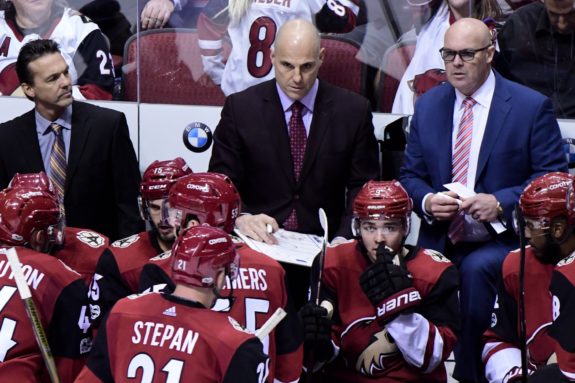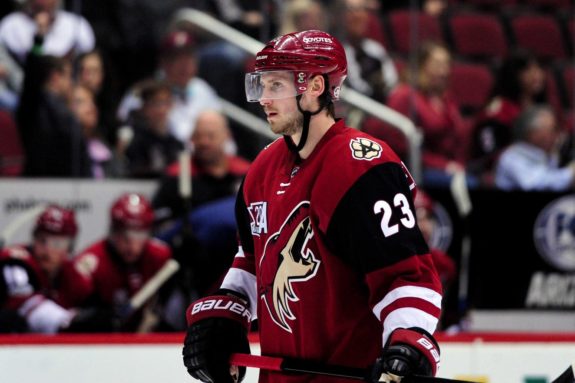There’s no question that the Arizona Coyotes are off to an absolutely brutal start to the 2017-18 season. They’ve failed to win a game in eight tries and are off to the worst start in franchise history by a wide margin.
Prior to this year, the Coyotes had never started a season with more than two consecutive losses since moving to Arizona – they last did so at the start of the lockout-shortened 2012-13 campaign. Even during the franchise’s early days in Winnipeg, the team never took this long to earn its first victory.

As an expansion team in 1979-80, the Jets won their third-ever game in the NHL, one of just 20 they’d win all year. During their ensuing nine-win 1980-81 campaign, the Jets once again won their third game of the season before going winless over their next 30.
Needless to say, the Coyotes are in rare territory with their horrendous start. With three more losses, Arizona will tie the 1943-44 New York Rangers for the longest losing streak to start a season – the Blueshirts lost 11 straight before snapping that streak with a tie against Montreal in game No. 12.
What’s gone wrong in Arizona this year? The list is long, but the two most glaring reasons for their season-opening losing streak have been missed opportunities and blown leads.
Missed Opportunities Plaguing Coyotes
Other than Clayton Keller’s standout performance, the story of the season for the Coyotes has, so far, been their inability to generate anything with their power play. Since scoring twice on the man advantage during the season opener against the Anaheim Ducks on Oct. 5, the Coyotes are just 2-for-26 on the power play. That’s a conversion rate of only 7.7%.
Obviously, that’s not going to cut it in the NHL, but what’s even more troubling is the fact that the Coyotes can’t get it done even when they’re skating at 5-on-3. Arizona leads the league in 5-on-3 power play time at 3:47 for the season, but they’ve somehow managed to go scoreless during four separate 5-on-3 situations.

It’s always costly when a team allows a 5-on-3 chance to go by the wayside, but the Coyotes’ failures on Saturday against the Chicago Blackhawks were especially egregious. During the first period, the Blackhawks took four minor penalties in a span of 2:08, including two simultaneously, which gave the Coyotes a lengthy 5-on-3 chance. Arizona could not get anything going, though, and generated only one shot on net during four minutes of power play time in the period.
Pretty sure that was more of the Coyotes’ power play being a mess than stellar penalty killing by the Hawks.
— Satchel Price (@SatchelPrice) October 22, 2017
It’s not just that the Coyotes aren’t scoring goals on the power play – they’re failing to even generate any sort of positive momentum. In fact, they seem to have given momentum back to Chicago following the Hawks’ long penalty kill on Saturday night.
Life Without Crosby?
Why is Arizona’s power play so bad? It could be that head coach Rick Tocchet is struggling to adjust to not having players like Sidney Crosby, Evgeni Malkin, and Phil Kessel at his disposal this season.
When the Coyotes are on the power play, it appears as if they’re trying to be too cute with the puck. They’re not shooting enough, and are instead passing the puck around the ice in search of the perfect play. With perennial All-Star players like Crosby, Malkin, and Kessel on the ice, this is a strategy that can be successful. However, in Arizona, this system has not yet paid dividends for Tocchet.

What can the Coyotes do to improve on the power play? The answer is simple – shoot the puck. Good things happen when you put the puck on net, but the Coyotes simply aren’t giving themselves enough chances to be successful.
Related – Monday Morning Howl: Improvement but Coyotes Still Winless
Coyotes Continue to Blow Leads
Another issue which has plagued Arizona all season is their inability to hold onto a lead once they score. Nine times this year, the Coyotes have conceded a goal less than two minutes after scoring one for themselves, and, on four of those occasions, the opposition answered in less than a minute.
9th time Coyotes have allowed an opponent to score within two minutes of scoring themselves. Toews. 1-1.
— Craig Morgan (@CraigSMorgan) October 22, 2017
Obviously, this is a trend that can’t continue. Good teams in the NHL keep their foot on the gas after scoring – they don’t allow their opponent to climb right back into the game. Clearly, with such a young team, there will be growing pains on the defensive end of the ice, but this is an area the Coyotes will need to quickly improve upon.
Overall, this season has been nothing short of a disaster so far in Arizona. The Coyotes can’t score at even strength or on the power play, and they can’t seem to keep the puck out of their net, either. The 2017-18 campaign has all the makings of another very long year in the Valley of the Sun.